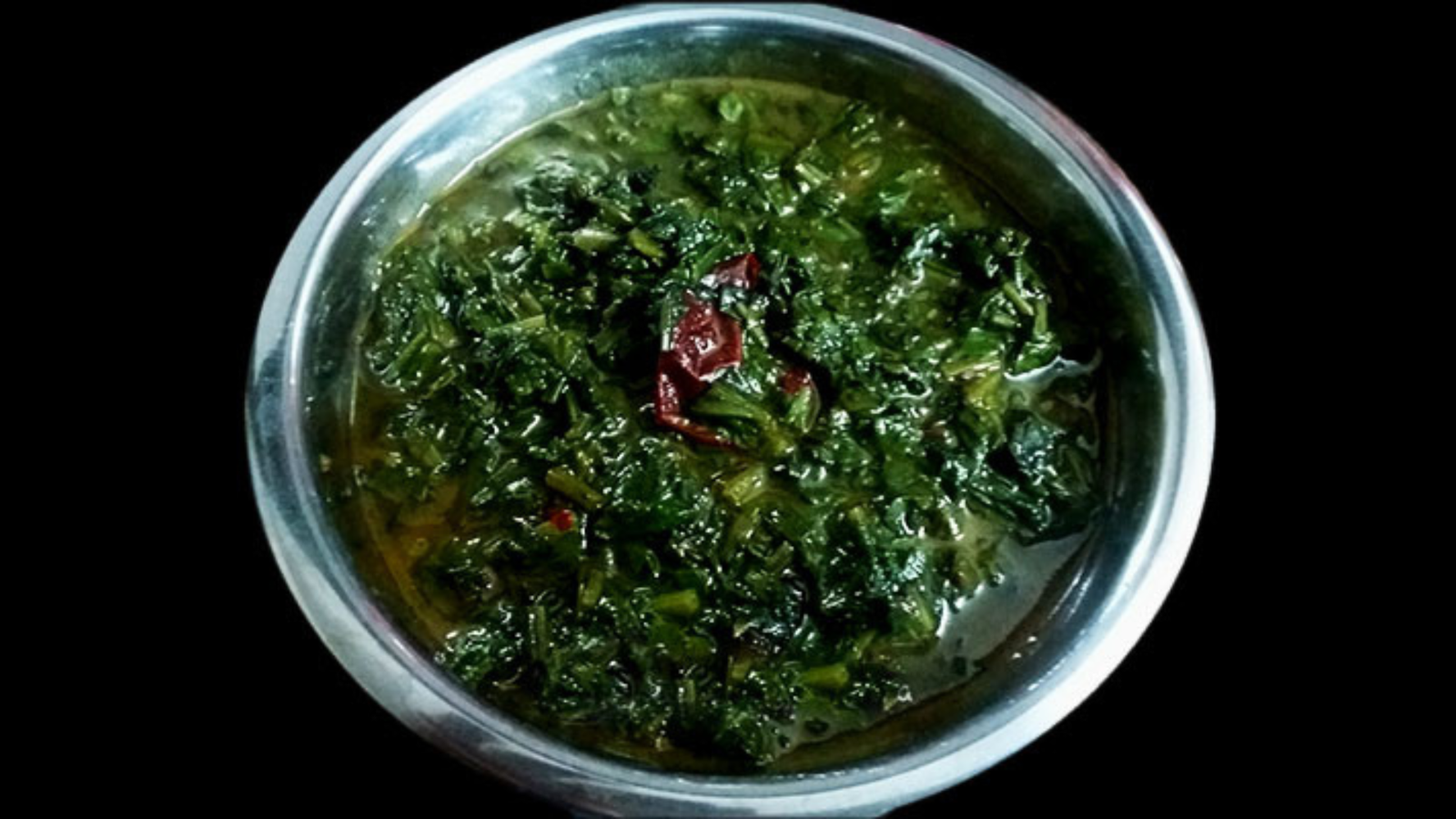If you’re keen on trying a tasty and nutritious dish from Uttarakhand, give Kafuli a shot. It’s a thick gravy made from green leafy veggies like spinach and fenugreek, cooked with spices and yogurt. People in Uttarakhand, particularly in Garhwal and Kumaon, love it as a staple. It’s often served with rice or roti. Kafuli is so beloved there that it’s considered the state food. Sometimes you might hear it called Kafali or Kafli in different areas of the state.
Kafuli is not only tasty, but also nutritious, as it is rich in iron, calcium, vitamin A and C, and antioxidants. It is a perfect dish for winters, as it keeps the body warm and energized. Kafuli is also easy to make, and requires only a few ingredients that are easily available. In this blog, we will show you how to make Kafuli, the state food of Uttarakhand, in a simple and authentic way.

Kafuli Recipe
Here are two delicious Kafuli recipes from Uttarakhand cuisine:
1. Kafuli Recipe (Ever Green Dishes)
- Ingredients:
- 2 bunches of spinach (palak)
- 1 bunch of fenugreek leaves (methi)
- 3 green chilies
- 2 tablespoons oil (preferably mustard oil)
- 1 teaspoon cumin seeds
- A pinch of asafoetida (hing)
- 2-inch piece of ginger
- 5 cloves of garlic
- 1/2 teaspoon turmeric powder
- 1/2 teaspoon coriander powder
- 1/2 teaspoon red chili powder (optional)
- 1 tablespoon curd (yogurt)
- 1 teaspoon rice flour
- Salt to taste
- Instructions:
- Wash the green leaves (spinach and fenugreek) and chop them.
- Boil the spinach, fenugreek leaves, and green chilies with half a cup of water until tender.
- Make a paste of ginger and garlic.
- Puree the boiled green leaves.
- Heat oil in a pan, add cumin seeds, ginger-garlic paste, and sauté.
- Add the puree, turmeric powder, coriander powder, salt, and water (as needed for consistency).
- Simmer and add a paste of rice flour and curd.
- Let it cook for a while.
- Serve Kafuli with phulka or chapati.

2. Uttaranchal Style Garwhali Kafuli Recipe (Archana’s Kitchen)
- Ingredients:
- 2 cups spinach leaves (palak)
- 1 cup fenugreek leaves (methi)
- 2 green chilies, chopped
- 1-inch ginger, chopped
- 1 teaspoon cumin powder (jeera)
- 1/2 teaspoon turmeric powder (haldi)
- 1 teaspoon coriander powder (dhania)
- A pinch of asafoetida (hing)
- 1 tablespoon rice flour
- 1/4 cup curd (yogurt)
- Salt to taste
- Oil
- Instructions:
- Boil spinach and fenugreek leaves with green chilies and a little water until tender.
- Blend into a smooth paste.
- Heat oil in a kadai, add ginger, and allow it to soften.
- Add the ground spinach paste, spices, and salt.
- Mix rice flour with water and stir it into the gravy.
- Add beaten curd and simmer until thickened.
- Garnish with ginger and serve with roti or rice.
Tips and Variations
- You can use any other green leafy vegetables of your choice, such as mustard greens, radish leaves, or amaranth leaves, to make Kafuli. You can also use a combination of different greens for more variety and flavor.
- You can add some ghee or butter on top of the Kafuli before serving, for extra richness and taste.
- You can also add some chopped onions and tomatoes to the gravy, if you like. However, this is not the traditional way of making Kafuli, and may alter the original flavor of the dish.
- You can also use besan (gram flour) instead of rice flour, to thicken the gravy. However, rice flour gives a more smooth and silky texture to the Kafuli.
- You can also skip the curd, if you are vegan or lactose intolerant. However, curd adds a nice tangy and creamy taste to the Kafuli, and is a favorite ingredient of the Garhwalis.
Where to Taste Kafuli in Uttarakhand

+If you want to taste the authentic Kafuli in Uttarakhand, then you should visit the local restaurants or dhabas that serve the traditional Garhwali and Kumaoni cuisine. You can find such places in the major towns and cities of Uttarakhand, such as Dehradun, Mussoorie, Nainital, Almora, Rishikesh, Haridwar, and others.
You can also try Kafuli in the homestays or guesthouses that are run by the local people in the villages or hill stations of Uttarakhand. You can also learn how to make Kafuli from them, and enjoy the hospitality and culture of the people of Uttarakhand.
Kafuli is a dish that reflects the simplicity, richness, and diversity of the cuisine of Uttarakhand. It is a dish that is loved by the locals and the tourists alike. It is a dish that you should not miss when you visit Uttarakhand. So, go ahead and try this recipe at home, or plan a trip to Uttarakhand and taste the real Kafuli there. You will surely fall in love with this dish, and the state that it belongs to.
FAQs
What is Kafuli?
Kafuli is a traditional dish from the Indian state of Uttarakhand, made primarily with green leafy vegetables like spinach and fenugreek leaves, seasoned with spices.
How to make Kafuli?
To make Kafuli, you boil spinach and fenugreek leaves, blend them into a paste, and cook with spices, rice flour, and curd to create a thick, flavorful curry.
Is Kafuli healthy?
Yes, Kafuli is considered healthy due to its high content of greens, providing essential vitamins and minerals with low calories.
Can Kafuli be made vegan?
Absolutely! Replace the curd with a plant-based yogurt alternative to make a vegan version of Kafuli.
What is Kafuli served with?
Kafuli is traditionally served with steamed rice or roti (Indian flatbread) for a complete meal.

